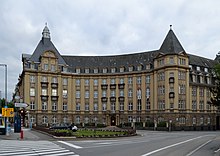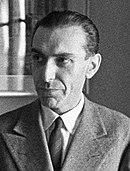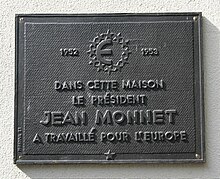
The High Authority was the executive branch of the former European Coal and Steel Community (ECSC). It was created in 1951 and disbanded in 1967 when it was merged into the European Commission.

The High Authority was the executive branch of the former European Coal and Steel Community (ECSC). It was created in 1951 and disbanded in 1967 when it was merged into the European Commission.
|
Further information: European Coal and Steel Community § History, and History of the European Union |
| History of the European Union |
|---|
 |
|
|
The High Authority was at the core of the idea of the ECSC. It was to be an independent, supranational executive checked by a Common Assembly.[1] There were concerns about this power, leading to a Council (of governments) and Parliament (of MPs) to be created to act as a counterweight.[2][3] The inaugural sitting of the Authority was held in Luxembourg's city hall on 10 August 1952. Jean Monnet, the architect of the ECSC, was elected as its first President.[4]
The supranational power exercised by the Authority did prompt suspicion by some, for example the government of France who ensured that in the European Economic Community (EEC) and European Atomic Energy Community (Euratom) more power would be in the hands of the council.[3][5][6]
The Merger Treaty came into force in 1967; this combined the independent institutions of the ECSC and Euratom with those of the EEC. From that time the High Authority ceased to exist, its duties being taken on by the Commission of the European Communities. The administration of Rinaldo Del Bo ended before the merger so an interim President was appointed to oversee the merger, Albert Coppé.[7] The Authority met for the last time on 28 June 1967.[8]
The Authority's principal innovation was its supranational character. It had a broad area of competence to ensure the objectives of the treaty were met and that the common market functioned smoothly. The High Authority could issue three types of legal instruments: Decisions, which were entirely binding laws; Recommendations, which had binding aims but with methods left to member states; and Opinions, which had no legal force.[9]
The body consisted of nine members, nearly all appointed from the member states. The larger states, France, Germany and Italy, appointed two members each with the three smaller states, Belgium, Luxembourg and the Netherlands appointing one member each. The ninth member was the President, who was appointed by the eight other members.[9]
Despite being appointed by national governments, the members were not supposed to represent their national interest, but rather took an oath to defend the general interests of the Community as a whole. Their independence was aided by members being barred from having any occupation outside the Authority or having any business interests.[9]
|
See also: President of the European Commission |
The President was elected by the other appointed members, rather than directly by member states (as is the case of the current Commission President). The first president was Jean Monnet.
| N. | Portrait | President (Born–Died) |
State | Took office | Left office | Authority | Party | Group | Electoral mandate | Refs | |
|---|---|---|---|---|---|---|---|---|---|---|---|
| 1 | 
|
Jean Monnet (1888–1979) |
10 August 1952 | 3 June 1955 | Monnet | Independent | None | – | |||
| 2 years, 297 days | |||||||||||
| 2 | 
|
René Mayer (1897–1965) |
3 June 1955 | 13 January 1958 | Mayer | PR | None | – | |||
| 2 years, 224 days | |||||||||||
| 3 | 
|
Paul Finet (1897–1995) |
13 January 1958 | 15 September 1959 | Finet | Independent | None | – | |||
| 1 year, 246 days | |||||||||||
| 4 | 
|
Piero Malvestiti (1899–1964) |
15 September 1959 | 22 October 1963 | Malvestiti | DC | None | – | |||
| 4 years, 51 days | |||||||||||
| 5 | 
|
Rinaldo Del Bo (1916–1991) |
22 October 1963 | 1 March 1967 | Del Bo | DC | None | – | |||
| 3 years, 130 days | |||||||||||
| 6 | 
|
Albert Coppé (1911–1999) |
1 March 1967 | 5 July 1967 | Coppé | CD&V | None | – | |||
| 126 days | |||||||||||
|
Further information: Institutional seats of the European Union |

The headquarters of the High Authority were in Luxembourg city, the seat of most ECSC institutions. This was only intended as the provisional seat as no formal agreement was reached at the ECSC's conference in 1952.[10]
Luxembourg had proposed it be the provisional seat (except for the Common Assembly which was to be in Strasbourg) until an agreement was reached.[11] Future executives, the Commissions of the EEC and Euratom, would eventually be based in Brussels.[10]
The High Authority first had its offices in hotels, initially the Hôtel des Forges in Chateau de Beggen and then the Hôtel Grand-Chef in Mondorf-les-Bains. In 1953 it moved to the former seat of Luxembourg Railways on Place de Metz in Luxembourg, a grand building that later hosted the European Investment Bank from 1968 to 1980 and, since 1987, headquarters offices of the Banque et Caisse d'Épargne de l'État.[12]